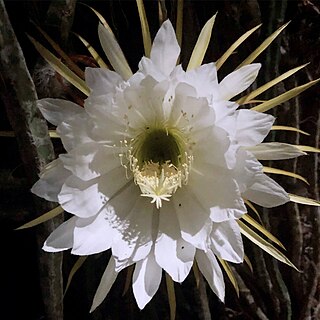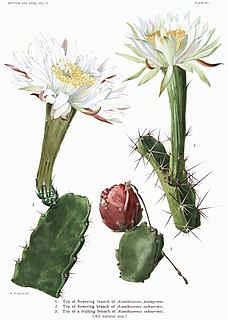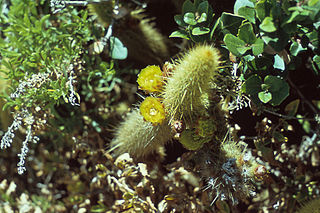
Bacillus is a genus of Gram-positive, rod-shaped bacteria, a member of the phylum Firmicutes, with 266 named species. The term is also used to describe the shape (rod) of certain bacteria; and the plural Bacilli is the name of the class of bacteria to which this genus belongs. Bacillus species can be either obligate aerobes: oxygen dependent; or facultative anaerobes: having the ability to continue living in the absence of oxygen. Cultured Bacillus species test positive for the enzyme catalase if oxygen has been used or is present.

Bacillus cereus is a Gram-positive, rod-shaped, facultatively anaerobic, motile, beta-hemolytic, spore forming bacterium commonly found in soil and food. The specific name, cereus, meaning "waxy" in Latin, refers to the appearance of colonies grown on blood agar. Some strains are harmful to humans and cause foodborne illness, while other strains can be beneficial as probiotics for animals. The bacteria is classically contracted from fried rice dishes that have been sitting at room temperature for hours. B. cereus bacteria are facultative anaerobes, and like other members of the genus Bacillus, can produce protective endospores. Its virulence factors include cereolysin and phospholipase C.

Night-blooming cereus is the common name referring to a large number of flowering ceroid cacti that bloom at night. The flowers are short lived, and some of these species, such as Selenicereus grandiflorus, bloom only once a year, for a single night. Other names for one or more cacti with this habit are princess of the night, Honolulu queen, Christ in the manger, dama de noche and queen of the night.

Acanthocereus is a genus of cacti. Its species take the form of shrubs with arching or climbing stems up to several meters in height. The generic name is derived from the Greek word άκανθα (acantha), meaning spine, and the Latin word cereus, meaning candle. The genus is native to the mostly tropical Americas from Texas and the southern tip of Florida to the northern part of South America, including islands of the Caribbean.

Bergerocactus emoryi is a species of cactus. It is the sole member of the genus Bergerocactus, named after Alwin Berger. The plant is also known as snake cactus, though this latter name also applies to Echinocereus pensilis.

Jasminocereus is a genus of cacti with only one species, Jasminocereus thouarsii, endemic to the Galápagos Islands, territorially a part of Ecuador. In English it is often called the candelabra cactus. At maturity it has a branched, treelike habit, and may be up to 7 m (23 ft) tall. The stems are made up of individual sections with constrictions between them. Its creamy white to greenish flowers open at night and are followed by greenish to reddish fruits.

The term ceroid cactus is used to describe any of the species of cacti with very elongated bodies, including columnar growth cacti and epiphytic cacti. The name is from the Latin cēreus, wax taper, referring to the stiff, upright form of the columnar species. Some species of ceroid cacti were known as torch cactus or torch-thistle, supposedly due to their use as torches by Native Americans in the past.

Selenicereus, sometimes known as moonlight cactus, is a genus of epiphytic, lithophytic, and terrestrial cacti, found in Mexico, Central America, the Caribbean and northern South America. The term night-blooming cereus is also sometimes used, but this is also used for many night-blooming cacti, including Epiphyllum and Peniocereus. In 2017, the genus Hylocereus was brought into synonymy with Selenicereus. A number of species of Selenicereus produce fruit that is eaten. The fruit, known as pitaya or pitahaya in Spanish or as dragon fruit, may be collected from the wild or the plants may be cultivated.

Peniocereus is a genus of vining cacti, comprising about 18 species, found from the southwestern United States and Mexico. They have a large underground tuber, thin and inconspicuous stems. Its name comes from the prefix penio- and Cereus, the large genus from which it was split.

The lava cactus is a species of cactus, Brachycereus nesioticus, the sole species of the genus Brachycereus. The plant is a colonizer of lava fields – hence its common name – where it forms spiny clumps up to 60 cm (24 in) tall. Its solitary white or yellowish white flowers open in the daytime. It is endemic to the Galápagos Islands.

Oreocereus is a genus of cacti, known only from high altitudes of the Andes. Its name means "mountain cereus", formed from the Greek prefix oreo- and the New Latin cereus, meaning wax or torch.

Selenicereus undatus, the white-fleshed pitahaya, is a species of Cactaceae and is the most cultivated species in the genus. It is used both as an ornamental vine and as a fruit crop - the pitahaya or dragon fruit. The native origin of the species has never been resolved.

Echinopsis spachiana, commonly known as the golden torch, (white) torch cactus or golden column, is a species of cactus native to South America. Previously known as Trichocereus spachianus for many years, it is commonly cultivated as a pot or rockery plant worldwide. It has a columnar habit, with a lime-green cylindrical body with 1–2 cm long golden spines.

Bacillus anthracis is a Gram-positive and rod-shaped bacterium that causes anthrax, a deadly disease to livestock and, occasionally, to humans. It is the only permanent (obligate) pathogen within the genus Bacillus. Its infection is a type of zoonosis, as it is transmitted from animals to humans. It was discovered by a German physician Robert Koch in 1876, and became the first bacterium to be experimentally shown as a pathogen. The discovery was also the first scientific evidence for the germ theory of diseases.
Cereus chalybaeus is a cactus from the genus Cereus, a genus consisting of about 25 species of tree-like cacti. Cereus chalybaeus is a columnar cactus with 5-6 ribbs. It is few-branched and often purple tinged. It has spines that at first are red, but with age turn black. In summer it bears funnel-shaped flowers, which can be up to 8 inches long. The inner petals are white and the outer petals are either purple or red. Cereus chalybaeus can grow up to 10 feet tall and can be up to 28 inches in diameter. This plant is native in hardiness zones 13-15.
In bacteriology, a taxon in disguise is a species, genus or higher unit of biological classification whose evolutionary history reveals has evolved from another unit of a similar or lower rank, making the parent unit paraphyletic. That happens when rapid evolution makes a new species appear so radically different from the ancestral group that it is not (initially) recognised as belonging to the parent phylogenetic group, which is left as an evolutionary grade.
Cereus elegans is a cactus species in the genus Cereus.

Cereus is a genus of cacti including around 33 species of large columnar cacti from South America. The name is derived from Greek (κηρός) and Latin words meaning "wax", "torch" or "candle". The genus Cereus was one of the first cactus genera to be described; the circumscription varies depending on the authority. The term "cereus" is also sometimes used for a ceroid cactus, any cactus with a very elongated body, including columnar growth cacti and epiphytic cacti.
Cereus, waxy in Latin, may refer to:
Ceylalictus cereus is a species of bee in the genus Ceylalictus, of the family Halictidae.















